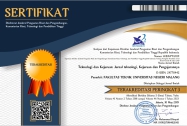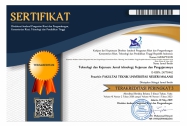Developing Lean-Based Learning Model to Improve Work Skills of Vocational Students
Abstract
Keywords
Full Text:
PDFReferences
Adrian, F. (2005). The Psychology of Behaviour at Work. the individual in the organization (2nd ed.). New York: Psychology Press.
Arifin, Z., Nurtanto, M., Priatna, A., Kholifah, N., & Fawaid, M. (2020). Technology andragogy work content knowledge model as a new framework in vocational education: Revised technology pedagogy content knowledge model. TEM Journal, 9(2), 786–791. https://doi.org/10.18421/TEM92-48
Blum, N. (2008). Environmental education in Costa Rica: Building a framework for sustainable development?. International Journal of Educational Development, 28(3), 348-358. https://doi.org/10.1016/j.ijedudev.2007.05.008,
Bruijn, E. de, Billett, S., & Onstenk, J. (n.d.). Enhancing teaching and learning in the Dutch vocational education system : reforms enacted.
Calhoun, C. C., & Finch, A. V. (1982). Vocational Education Concept and Operation. Belmont, California: Wadsworth Publishing Company. Hal 60.
Chaturvedi, A., Yadav, A., & Bajpai, S. (2011). Communicative approach to soft and Hard skills. Journal VSRD-International of bussiness & management research, 1(1), 1-6.
Coates, E.D. (2006. People Skill Training. http://www.2020insight.net/docs4/peopleskills.pdf, (2006).
Eggen. P., & Kauchak. D. (2012). Strategi dan Model Pembelajaran. Mengajarkan konten dan ketrampilan berpikir. Edisi 6. Terjemahan. Jakarta: PT. Indeks
Gaspersz, V. (2017). Lean Six Sigma for Manufacturing and Service Industries Strategi Dramatik Reduksi Cacat/Kesalahan, Biaya, Inventori, Dan Lead Time Dalam Waktu Kurang Dari 6 Bulan. Jakarta: Gramedia Pustaka Utamas
Hartanto, S. (2017). Need and Analysis of Soft Skills for Students of the Mechanical Engineering Department of Vocational High School. International Journal of GEOMATE, 12(30), 156–159. https://doi.org/10.21660/2017.30.tvet017
Hartanto, S., Handoko, Z. A., Huda, A., Fordiana, R., & Yeni, N. (2019). Learning Material Analysis of Motorcycle Engine Tune-Up Practice Competency of Vocational High School Students. International Journal of Recent Technology and Engineering (IJRTE). ISSN, 2277-3878.
Hartanto, S., Lubis, S., & Rizal, F. (2017). Need and analysis of soft skills for students of the mechanical engineering department of vocational high school. International Journal, 12(30), 156-159
Hidayati, R. M., & Wagiran, W. (2020). Implementation of problem-based learning to improve problem-solving skills in vocational high school. Jurnal Pendidikan Vokasi, 10(2), 177–187. https://doi.org/10.21831/jpv.v10i2.31210
Jalinus, N., Nabawi, R. A., & Mardin, A. (2017). The Seven Steps of Project Based Learning Model to Enhance Productive Competences of Vocational Students. 102(Ictvt), 251–256. https://doi.org/10.2991/ictvt-17.2017.43
Joyce. B, Weil. M, & Calhoun. E. (2009). Models of Teaching, Model-model Pengajaran. Terjemahan edisi kedua. Yogyakarta: Pustaka Pelajar.
Li, C., Huang, J., Wang, J., Yang, J., & Tian, G. (2019). Study and Practice on Skills Competition Help Vocational Education Students Growing up. IOP Conference Series: Materials Science and Engineering, 573(1). https://doi.org/10.1088/1757-899X/573/1/012073
Liker, J. K., & Meier, D. The Toyota Way Fieldbook: A Practical Guide for Implementing Toyota’s 4Ps, 2006. Bok-McGraw-Hill Professional.
Lubis, S. (2010, November). Concept and implementation of vocational pedagogy in TVET teacher education. In Proceedings of the 1st International UPI conference on TVET, Bandung Indonesia (pp. 10-11).
Majid, S., Liming, Z., Tong, S., & Raihana, S. (2012). Importance of soft skills for education and career success. International Journal for Cross-Disciplinary Subjects in Education, 2(2), 1037-1042.
Martin, A., Hughes, H., & Martin, A. (2009). How to Make the Most of Work Integrated Learning: A Guide for Students. In Lecturers & Supervisors", Massey University, Private Bag 11222 Palmerston North 5301 New Zealand.
Mazoota.A.R. (2015). “Workplace Soft Skills vs. Hard Skills – Which are More Important?”. https://www.armazzotta.com/blog/2015/07/07/workplace-soft-skills-vs-hard-skills-which-are-more-important/.
Palmer, R. (2007). Skills for work?: From skills development to decent livelihoods in Ghana's rural informal economy. International journal of educational development, 27(4), 397-420. DOI:10.1016/j.ijedudev.2006.10.003.
Prosers. C.A & T. Quigley. (1949). Vocational education in a democracy, American Technical society, Chicago. http://www.morgancc.edu/.../prossers.
Rani, E., & Mangala, S. (2010). Need and importance of soft skills in students. Journal of Literature, culture and Media studies, 2(3).
Robles, M. Marcel, 2012,“Executive Perceptions of the Top 10 Soft Skills Needed in Today's Workplace” in. Business Communication Quarterly, 75(4), 453-465.
Sa-Nguanmanasak, T., & Khampirat, B. (2019). Comparing employability skills of technical and vocational education students of Thailand and malaysia: A case study of international industrial work-integrated learning. Journal of Technical Education and Training, 11(3), 94–109. https://doi.org/10.30880/jtet.2019.11.03.012
Sari, Y. I. H., Soelistiyowati, E., & Yuanti, E. E. (2020). Work ethics profile of vocational college students in Indonesia. Jurnal Pendidikan Vokasi, 10(3), 260–269. https://doi.org/10.21831/jpv.v10i3.33809
Sousa, D. A. (2011). Commentary: Mind, brain, and education: The impact of educational neuroscience on the science of teaching. Learning landscapes, 5(1), 37-43
Ståhl, A. C. F., Gustavsson, M., Karlsson, N., Johansson, G., & Ekberg, K. (2015). Lean production tools and decision latitude enable conditions for innovdecisionative learning in organizations: A multilevel analysis. Applied Ergonomics, 47, 285-291. https://doi.org/10.1016/j.apergo.2014.10.013.
Sundar, R., Balaji, A. N., & Kumar, R. S. (2014). A review on lean manufacturing implementation techniques. Procedia Engineering, 97, 1875-1885.
Wilson, L. (2010). How to implement lean manufacturing. McGraw-Hill Education.
DOI: http://dx.doi.org/10.17977/um031v44i12021p28-33
Refbacks
- There are currently no refbacks.
Copyright (c) 2021 Teknologi dan Kejuruan: Jurnal Teknologi, Kejuruan, dan Pengajarannya
Teknologi dan Kejuruan: Jurnal Teknologi, Kejuruan, dan Pengajarannya
E-ISSN 2477-0442 (online)
Contact
Faculty of Engineering, Universitas Negeri Malang (UM)
Jl. Semarang No 5 Malang 65145, Building H5, 1st Floor.
Homepage: http://journal2.um.ac.id/index.php/teknologi-kejuruan
Email: teknologikejuruan.ft@um.ac.id

This work is licensed under a Creative Commons Attribution 4.0 International License.



2.png)
1.png)
1.png)
1.png)
4.png)
1.png)
.png)

3.png)
1.png)
1.png)


